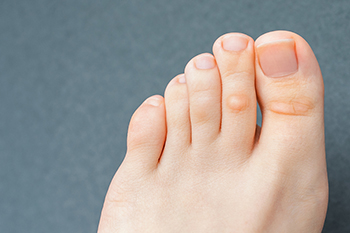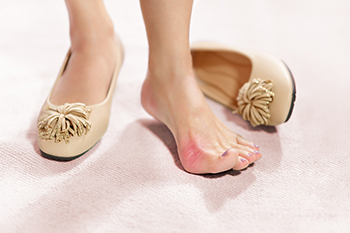

Corns are thickened areas of skin that can occur on the feet due to friction or pressure. They develop naturally to help protect the skin underneath them. They are commonly seen on the tops and sides of the toes and the balls of the feet. Corns can be hard and dry or soft and mushy. Corns can be caused by arthritis or poorly fitting shoes. Home treatment of corns usually consists of soaking the affected foot in warm water until the skin softens, and then gently filing the corn down with a pumice stone. One needs to use care when with this process and be sure to not press too hard to avoid bleeding and possible infection. Adding a donut-shaped adhesive pad around the corn can help the corn from touching the inside of the shoe. Routine foot care, including moisturizing the feet and keeping the toenails trimmed properly, are good preventative measures. If you are not sure why you have developed a corn, it becomes painful, or is not healing properly, see a podiatrist for treatment.
Corns can make walking very painful and should be treated immediately. If you have questions regarding your feet and ankles, contact Dr. Harris L. Klear of Burlington County Podiatry Associates. Our doctor will treat your foot and ankle needs.
Corns: What Are They? And How Do You Get Rid of Them?
Corns are thickened areas on the skin that can become painful. They are caused by excessive pressure and friction on the skin. Corns press into the deeper layers of the skin and are usually round in shape.
Ways to Prevent Corns
There are many ways to get rid of painful corns such as:
Treating Corns
Although most corns slowly disappear when the friction or pressure stops, this isn’t always the case. Consult with your podiatrist to determine the best treatment option for your case of corns.
If you have any questions please feel free to contact one of our offices located in Marlton and Delran, NJ . We offer the newest diagnostic and treatment technologies for all your foot and ankle needs.

Gout and plantar fasciitis are two very distinct and foot conditions. However, sometimes individuals might not be able to tell the difference between these two afflictions of the foot. This is because both foot conditions can result in forefoot pain and are associated with inflammation. Also, both conditions may affect the arch of the foot. Gout occurs when an excessive amount of uric acid develops in the blood. As a result, joints and other areas of the feet can experience pain. Plantar fasciitis, on the other hand, is caused by something much different. This condition occurs when the plantar fascia, the band of tissues in the arch of the foot, becomes inflamed. Therefore, one can see that both gout and plantar fasciitis are caused by different phenomena. If you think you might have one of these conditions, contact a podiatrist today.
Gout is a foot condition that requires certain treatment and care. If you are seeking treatment, contact Dr. Harris L. Klear from Burlington County Podiatry Associates. Our doctor will treat your foot and ankle needs.
What Is Gout?
Gout is a type of arthritis caused by a buildup of uric acid in the bloodstream. It often develops in the foot, especially the big toe area, although it can manifest in other parts of the body as well. Gout can make walking and standing very painful and is especially common in diabetics and the obese.
People typically get gout because of a poor diet. Genetic predisposition is also a factor. The children of parents who have had gout frequently have a chance of developing it themselves.
Gout can easily be identified by redness and inflammation of the big toe and the surrounding areas of the foot. Other symptoms include extreme fatigue, joint pain, and running high fevers. Sometimes corticosteroid drugs can be prescribed to treat gout, but the best way to combat this disease is to get more exercise and eat a better diet.
If you have any questions please feel free to contact one of our offices located in Marlton and Delran, NJ . We offer the newest diagnostic and treatment technologies for all your foot and ankle needs.

A bunion is a foot condition involving a bony protrusion on the side of the big toe and is easy to notice. It is considered to be a deformity, and may cause the toes to shift towards each other. A common reason why people can develop bunions is from wearing shoes that are too small in the toe area. This can force the toes to squeeze together, and be uncomfortable. In severe cases, walking may become difficult, and larger shoes may need to be purchased that can accommodate the bunion. Research has shown that family genes may contribute to developing a bunion. Additionally, arthritis may lead to getting a bunion, as a result of inflamed toe joints. Symptoms of this ailment can include pain and swelling surrounding the big toe, and there may be calluses and corns that form on top of the bunion as it touches the side of the shoe. Mild relief may come from wearing a protective pad over the bunion, and orthotics may be prescribed that may help to realign the foot structure. If you have a bunion, it is strongly urged that you contact a podiatrist who can recommend the correct treatment options, which may include surgery for permanent removal.
If you are suffering from bunion pain, contact Dr. Harris L. Klear of Burlington County Podiatry Associates. Our doctor can provide the care you need to keep you pain-free and on your feet.
What Is a Bunion?
Bunions are painful bony bumps that usually develop on the inside of the foot at the joint of the big toe. As the deformity increases over time, it may become painful to walk and wear shoes. Women are more likely to exacerbate existing bunions since they often wear tight, narrow shoes that shift their toes together. Bunion pain can be relieved by wearing wider shoes with enough room for the toes.
Causes
Symptoms
In order to diagnose your bunion, your podiatrist may ask about your medical history, symptoms, and general health. Your doctor might also order an x-ray to take a closer look at your feet. Nonsurgical treatment options include orthotics, padding, icing, changes in footwear, and medication. If nonsurgical treatments don’t alleviate your bunion pain, surgery may be necessary.
If you have any questions, please feel free to contact one of our offices located in Marlton and Delran, NJ . We offer the newest diagnostic and treatment technologies for all your foot care needs.

Diabetes is a serious condition and can lead to complications regarding the feet if not under the care of a podiatrist. Elevated blood sugar levels may lead to the inability to feel existing cuts on the feet. These can easily develop into foot ulcers and may be controlled by implementing healthy lifestyle habits. Drinking plenty of water daily, reducing sugar intake, and practicing a gentle exercise regime are a few ways that can guide the diabetic person to possibly feeling better. It is necessary to pay close attention to the feet, and the soles can be inspected daily by using a mirror. This is an effective method for noticing any cuts, bruises, or scrapes that have developed, and they may be easier to see than to feel. Good foot hygiene consists of trimming the toenails weekly, which is often performed by a podiatrist. Diabetic patients may notice the skin on their feet is excessively dry and cracked, which may indicate additional foot problems. If you have diabetes, it is strongly advised that you are under the care of a podiatrist who can treat this ailment, and help you manage it.
Diabetic foot care is important in preventing foot ailments such as ulcers. If you are suffering from diabetes or have any other concerns about your feet, contact Dr. Harris L. Klear from Burlington County Podiatry Associates. Our doctor can provide the care you need to keep you pain-free and on your feet.
Diabetic Foot Care
Diabetes affects millions of people every year. The condition can damage blood vessels in many parts of the body, especially the feet. Because of this, taking care of your feet is essential if you have diabetes, and having a podiatrist help monitor your foot health is highly recommended.
The Importance of Caring for Your Feet
Patients with diabetes should have their doctor monitor their blood levels, as blood sugar levels play such a huge role in diabetic care. Monitoring these levels on a regular basis is highly advised.
It is always best to inform your healthcare professional of any concerns you may have regarding your feet, especially for diabetic patients. Early treatment and routine foot examinations are keys to maintaining proper health, especially because severe complications can arise if proper treatment is not applied.
If you have any questions please feel free to contact one of our offices located in Marlton and Delran, NJ . We offer the newest diagnostic and treatment technologies for all your foot and ankle needs.

Human feet are complex. Of the 208 bones in the body, 52 of them are in the feet. Feet also provide major service to the body with support, balance, and propulsion. It is necessary for dancers to properly take care of their feet because they depend on the complexity of their feet to dance. They must do what they can to prevent and treat minor injuries and take good care of their feet as a way of life to keep moving. Things they can do include cutting their toenails short and straight across, not wearing colored nail polish so they can see problems brewing under their toenails, keeping calluses trimmed, wearing tights with ballet shoes to help prevent corns from developing, and taking care of foot problems as they arise. If you are a dancer, or if your child is starting to dance, and you would like to learn more about taking care of a dancer’s feet, consult with a podiatrist.
Ankle and foot injuries are common among athletes and in many sports. They can be caused by several problems and may be potentially serious. If you are feeling pain or think you were injured in a sporting event or when exercising, consult with Dr. Harris L. Klear from Burlington County Podiatry Associates. Our doctor will assess your condition and provide you with quality foot and ankle treatment.
Common Injuries
The most common injuries that occur in sporting activities include:
Symptoms
Symptoms vary depending upon the injury and in some cases, there may be no symptoms at all. However, in most cases, some form of symptom is experienced. Pain, aching, burning, bruising, tenderness, tightness or stiffness, sensation loss, difficulty moving, and swelling are the most common symptoms.
Treatment
Just as symptoms vary depending upon the injury, so do treatment options. A common treatment method is known as the RICE method. This method involves rest, applying ice, compression and elevating the afflicted foot or ankle. If the injury appears to be more serious, surgery might be required, such as arthroscopic or reconstructive surgery. Lastly, rehabilitation or therapy might be needed to gain full functionality in the afflicted area. Any discomfort experienced by an athlete must be evaluated by a licensed, reputable medical professional.
If you have any questions, please feel free to contact one of our offices located in Marlton and Delran, NJ . We offer the newest diagnostic and treatment technologies for all your foot care needs.